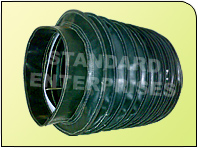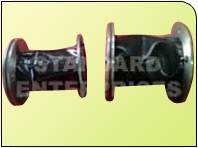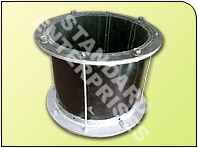Rubber Expansion Joint are made up of Neoprene, EPDM, Silicone, Viton and also in Natural Rubber etc, Ami's Rubber Expansion Bellows are reinforced with specially treated Nylon, Rayon,Glass Fiber, Fiber, Steel Cord etc, by taking care of the designing for perfect balance between movements of Axial, Radial, Torsion and Angular and pressure bearing capacity. Ami's Rubber Expansion Bellows are available in sizes ranging from 1" NB to 72" NB with hydro testing upto 24-bar pressure. These bellows are either integrated (metallic flanges are bonded with rubber) or split back-up flanges, and are made strictly as per the customer's design, drawing and specification.
Rubber Expansion Joint
Rubber expansion joints, often referred to as flexible rubber connectors or simply rubber bellows, are devices designed to absorb movements and vibrations in piping systems. These movements can be the result of thermal expansion/contraction, misalignment, vibrations from equipment, or seismic activity. Rubber expansion joints provide a solution by offering flexibility while also reducing noise and compensating for misalignment.
Rubber Expansion Joint are made up of Neoprene, EPDM, Silicone, Viton and also in Natural Rubber etc, Ami's Rubber Expansion Bellows are reinforced with specially treated Nylon, Rayon, Glass Fiber, Fiber, Steel Cord etc, by taking care of the designing for perfect balance between movements of Axial, Radial, Torsion and Angular and pressure bearing capacity. Ami's Rubber Expansion Bellows are available in sizes ranging from 1" NB to 72" NB with hydro testing up to 24-bar pressure.These bellows are either integrated (metallic flanges are bonded with rubber) or split back-up flanges, and are made strictly as per the customer's design, drawing and specification.
Rubber Expansion Joint key features:Rubber expansion joints are crucial components in many piping systems, allowing for movement and flexibility while reducing stress, noise, and vibration. Here are some key features and benefits of rubber expansion joints:
- Flexibility: Rubber expansion joints are designed to allow for axial, lateral, and angular movement, making them versatile for different applications.
- Noise and Vibration Reduction: The elastic nature of rubber helps in dampening vibrations and reducing noise transmission, which can be caused by pumps, compressors, or other equipment.
- Corrosion Resistance: Rubber is inherently resistant to many chemicals and corrosive substances, providing long-lasting performance.
- Absorb Thermal Expansion and Contraction: As temperatures fluctuate, piping systems can expand or contract. Rubber expansion joints accommodate these changes, ensuring the system remains intact.
- Protection Against Surge Effects: They can absorb and minimize the impact of pressure surges or water hammer, which could otherwise damage pipes and equipment.
- Reduced Stress on Equipment and Anchors: By absorbing movement and thermal changes, rubber expansion joints minimize the stress exerted on anchors, pumps, and other equipment.
- Easy Installation and Maintenance: Many rubber expansion joints are lightweight compared to metal alternatives, making them easier to install and replace.
- Extended Lifespan: Rubber joints reduce wear and tear on the piping system and equipment, potentially increasing the overall lifespan of the system.
- Temperature Resistance: Certain rubber materials can handle a wide range of temperatures, from the very cold to the very hot, making them suitable for various applications.
- Variety of Rubber Materials: Depending on the application, rubber expansion joints can be made from different types of rubber like EPDM, neoprene, nitrile, and natural rubber, each offering specific properties suitable for various fluids and temperatures.
- Customizable: Depending on the manufacturer, rubber expansion joints can be customized in terms of size, shape, and material to fit specific requirements of a project.
- Flange Configuration: They can be provided with various flange configurations to suit different installation requirements.
- Bolstered with Reinforcing Materials: To provide additional strength and durability, many rubber expansion joints are reinforced with materials like nylon or other fabrics.
- Reduced System Downtime: Their use can lead to fewer breakdowns and maintenance requirements, reducing the downtime of the whole system.
When selecting a rubber expansion joint, it's essential to consider factors like temperature, pressure, chemicals present in the system, and the expected movements. Consulting with the manufacturer or supplier can help ensure you select the right joint for your specific application.
Benefits of Rubber Expansion Joint:Rubber expansion joints, also known as rubber bellows or flexible connectors, are specialized devices that are commonly used in piping systems. They serve a range of purposes and provide multiple benefits, including:
- Vibration and Shock Absorption: Rubber expansion joints can absorb, and isolate vibrations caused by equipment, such as pumps or compressors. This helps protect the piping system and adjacent equipment from vibration-related wear and potential damage.
- Thermal Expansion and Contraction: Piping systems can expand or contract due to temperature changes. Rubber expansion joints can accommodate this movement, preventing stress on the pipes.
- Misalignment Compensation: During installation or due to ground settling, pipes might not always align perfectly. Rubber expansion joints can compensate for minor misalignments, eliminating the need for precise pipe alignment.
- Noise Reduction: The flexible nature of rubber dampens and reduces noise propagation through piping systems.
- Protecting from Water Hammer: Rapid changes in the velocity of fluid in a pipeline, such as shutting off a valve quickly, can result in water hammer. Rubber expansion joints can help absorb the energy from such events, reducing potential damage.
- Chemical Resistance: Rubber expansion joints can be made from various elastomers (like EPDM, NBR, or Neoprene), which can be selected based on the type of fluid in the piping system, ensuring chemical compatibility and longevity.
- Ease of Installation: Due to their flexibility, rubber expansion joints can be more forgiving during installation, making it easier to fit them into existing systems.
- Compensation for Lateral, Axial, and Angular Movements: Rubber expansion joints can compensate for multiple types of movement in a piping system, allowing for flexibility in all directions.
- Reduction in System Stress: By accommodating movement, expansion joints can reduce the stress on anchoring points and support structures, extending the lifespan of the entire system.
- Low Maintenance: Rubber expansion joints typically require minimal maintenance, and they can be easily inspected and replaced if necessary.
- Cost-Effective: When considering the potential damage to equipment, downtime, and maintenance due to the absence of expansion joints, they prove to be a cost-effective solution in the long run.
- Protection against Seismic Events: In regions prone to earthquakes, rubber expansion joints can help in absorbing movements caused by seismic events, thus minimizing potential damage to the piping system.
To ensure maximum benefit, it's essential to select the appropriate type of rubber expansion joint based on the specific requirements of the application. Regular inspection and maintenance also ensure that they continue to function effectively and protect the piping system.
Common Types of Rubber Used in Expansion Joints:- EPDM (Ethylene Propylene Diene Monomer): Good for hot water, steam, and various chemicals. It's not suitable for oils and hydrocarbons.
- Neoprene: Offers good resistance to weathering and many oils and chemicals.
- Nitrile (Buna-N): Suitable for oil-based products.
- Natural Rubber: Good for abrasive materials like slurries.
- Viton (FKM): Resistant to a wide range of chemicals and has high-temperature capabilities.
- It's essential to choose the right expansion joint for the specific application in terms of movement capabilities, temperature, pressure, and chemical resistance.
- Ensure that the expansion joint isn't over-extended or over-compressed once installed.
- Regularly inspect the rubber expansion joint for wear, cracks, or other damages.
- Ensure the correct alignment and anchoring of the piping system to prevent undue stress on the joint.
In conclusion, rubber expansion joints are versatile tools in various industries, from HVAC systems to water treatment plants and more. Proper selection, installation, and maintenance are key to ensuring they function as intended and prolong the lifespan of the associated equipment and piping systems.



